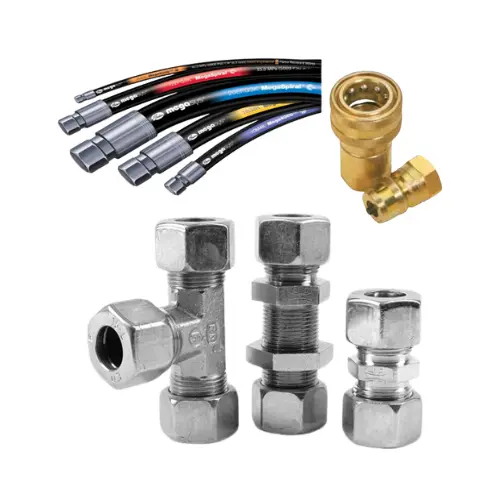Contact : +91-79045 61980 | Email: hydrofitengineers@gmail.com
What are the different types of hydraulic fittings ?
What is a hydraulic fitting ?
Hydraulic systems play a crucial role in various industries, from construction and agriculture to manufacturing and aerospace. These systems rely on the smooth and efficient flow of hydraulic fluid under high pressure to perform tasks such as lifting, pushing, and pulling. One essential component that ensures the reliability and safety of these systems is the hydraulic fitting.
Definition and Purpose of Hydraulic Fittings
A hydraulic fitting is a connector used to join different components of a hydraulic system, such as hoses, pipes, and tubes. The primary purpose of these fittings is to create a secure, leak-free connection that can withstand the high pressures and extreme conditions typical of hydraulic systems. By providing a robust and durable link, hydraulic fittings help maintain the integrity of the hydraulic circuit and prevent the escape of fluid, which could otherwise lead to system failure or safety hazards.
Types of Hydraulic Fittings
Hydraulic fittings come in various shapes, sizes, and configurations to accommodate different system requirements and specifications. Some of the most common types include:
- Threaded Fittings: These fittings have threads that allow them to be screwed into place, providing a tight seal. They are often categorized by thread type, such as NPT (National Pipe Thread), BSP (British Standard Pipe), or metric threads.
- Compression Fittings: These fittings use a compression ring to create a seal between the fitting and the pipe or tube. As the fitting is tightened, the ring is compressed against the pipe, forming a secure connection.
- Flange Fittings: Flange fittings use a flat, round disc with holes around the perimeter to connect pipes or hoses. Bolts are inserted through the holes to secure the connection, making it ideal for larger diameter hoses and pipes that require high-pressure capabilities.
- O-ring Face Seal (ORFS) Fittings: These fittings feature an O-ring that sits in a groove on the face of the fitting. When the fitting is tightened, the O-ring compresses against the mating surface, creating a leak-proof seal. ORFS fittings are widely used in high-pressure applications due to their reliability.
- Quick-Disconnect Fittings: Designed for easy and fast connection or disconnection, these fittings are commonly used in systems where frequent maintenance or equipment changes are required. They typically feature a push-and-pull mechanism for rapid engagement and disengagement.
- Elbow, Tee, and Cross Fittings: These fittings change the direction of the hydraulic flow or split it into multiple paths. Elbow fittings create a 45° or 90° angle, tee fittings split the flow into two, and cross fittings allow it to flow in four directions.
Material composition
Hydraulic fittings are made from various materials depending on the application, pressure requirements, and environmental conditions. Common materials include:
- Steel: Known for its strength and durability, steel is commonly used in high-pressure hydraulic systems.
- Stainless Steel: Offers corrosion resistance, making it suitable for harsh environments and applications involving corrosive fluids.
- Brass: Used in lower-pressure applications, brass offers good corrosion resistance and is often found in general industrial and plumbing applications.
- Aluminum: Lightweight and corrosion-resistant, aluminum fittings are often used in aerospace and automotive applications.
Importance of Choosing the right type of Hydraulic Fitting
Selecting the correct hydraulic fitting is critical to the performance and safety of a hydraulic system. An improperly chosen fitting can lead to leaks, pressure loss, or even catastrophic failure, potentially causing damage to equipment and injury to personnel. Factors to consider when choosing a fitting include:
- Pressure Rating: Ensure the fitting can withstand the maximum operating pressure of the system.
- Material Compatibility: The fitting material should be compatible with the hydraulic fluid and the environmental conditions.
- Thread Type: Matching the thread type of the fitting with the hose or pipe is essential to avoid leaks.
- Size: The fitting must match the diameter of the hose or pipe to ensure a secure connection.
Hydraulic fittings are small yet vital components of hydraulic systems, responsible for maintaining the integrity of fluid connections under high pressure. By understanding the different types of fittings, their materials, and their applications, you can make informed decisions that enhance the performance, reliability, and safety of your hydraulic systems. Whether you’re working on a complex industrial project or a simple hydraulic application, the right fitting can make all the difference.

